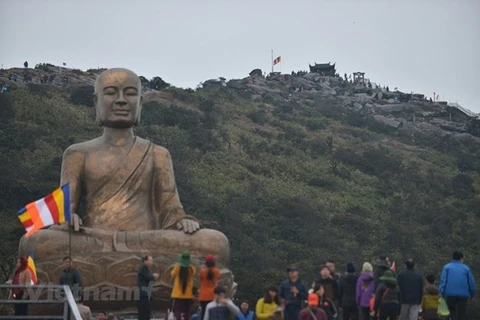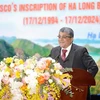 Truc Lam Yen Tu Zen Monastery, also known as Lan Pagoda, was where King Tran Nhan Tong (1258-1308) chose to lead a religious life. The original pagoda suffered damage over time and was re-built in 2002 (Photo: VNA)
Truc Lam Yen Tu Zen Monastery, also known as Lan Pagoda, was where King Tran Nhan Tong (1258-1308) chose to lead a religious life. The original pagoda suffered damage over time and was re-built in 2002 (Photo: VNA) Hanoi (VNA) - The northern provinces of Quang Ninh, Hai Duong and Bac Giang will join hands to complete a scientific dossier on the Complex of Yen Tu Monuments and Landscapes in 2022, to seek UNESCO recognition of the location as a world heritage site.
Coordination in compilation of dossier
Under the commitment, which was signed by the People’s Committees of the three neighbouring provinces recently, the localities are set to work together to finalise the initial nomination dossier and submit it to the Ministry of Culture, Sports and Tourism by July 30, 2022.
After making necessary revisions, if any, they will submit the dossier to UNESCO for evaluation by September 30 and the official dossier to the Paris-headquartered organisation by December 31 this year.
In July 2020, the culture and sports departments of the three provinces held a meeting on the dossier building.
They agreed on an action programme to give consultations to local leaders regarding the establishment of a steering board for the dossier making, and a working group in charge of assisting the steering board, along with advice on the roadmap for dossier building.
In January 2021, Deputy Prime Minister Vu Duc Dam assigned the Ministry of Culture, Sports and Tourism to work with the Vietnam National UNESCO Committee to send a brief report to the UNESCO World Heritage Centre, to ask for the inclusion of the complex in the list of those planned to have world heritage dossiers compiled.
This brief report will replace the one currently posted on the website of the UNESCO World Heritage Centre.
The Deputy PM also ordered the People’s Committee of Quang Ninh to coordinate with its counterparts in Bac Giang and Hai Duong, as well as related agencies, to compile a dossier seeking world heritage status for the Complex of Yen Tu Monuments and Landscape.
The committees will consider, approve and finance the excavation at certain relic sites to gain more scientific evidence proving the site’s values.
In recent times, authorities of the three provinces have organised many meetings and symposiums to identify the globally outstanding values of the complex. So far, the first phase of the dossier making has been completed.
A place of peace dating back to the Tran dynasty
The complex comprises four clusters of special national historical relics; the Yen Tu historical relic and landscape area (Uong Bi city of Quang Ninh), the Tran Dynasty historical relic area (Dong Trieu town of Quang Ninh), the Tay (Western) Yen Tu relic and landscape area (Bac Giang), and the Con Son-Kiep Bac-Thanh Mai complex (Hai Duong).
A large number of these relics and landscapes, including historical relics, architectural-artistic relics, archaeological relics and scenic landscapes, have been recognised to be of provincial or national importance.
These sites boast a harmonious combination of natural landscapes and architectural structures with special value, such as the pagodas of Bi Thuong, Suoi Tam, Cam Thuc, Lan, Giai Oan, and Hon Ngoc Garden of Towers.
The complex also holds great historical significance as it is the birthplace of the Vietnamese Zen Buddhism founded by King-Monk Tran Nhan Tong (1258-1308).
 Thau Ngoc bridge at Con Son Pagoda, part of the Con Son-Kiep Bac relic site in Hai Duong province (Photo: VNA)
Thau Ngoc bridge at Con Son Pagoda, part of the Con Son-Kiep Bac relic site in Hai Duong province (Photo: VNA) The foundation and development of the Truc Lam Yen Tu Zen Buddhist sect in this place left valuable scriptures and books for monks and ordinary people. The writings have become precious cultural heritages, accompanying the country throughout history.
In addition, Yen Tu Mountain is also home to a large number of rare fauna and flora species that cannot be found anywhere else.
The beauty of Yen Tu lies in the magnificence of its mountains, the solemnity of its pagodas and towers, the poetry of its landscapes, and the diversity of its plants. It used to be listed as one of the 72 “phuc dia” (lands of happiness) in the country.
Given the particularly important values of Yen Tu, the State issued Decision 15/VH-QD on March 13, 1974 to recognise the Complex of Yen Tu Monuments and Landscapes as a national relic site.
On September 27, 2012, the Prime Minister issued Decision 1419/QD-TTg to name this complex a special national relic site.
Yen Tu was also recognised as the Buddhist centre of Vietnam at the third National Buddhist Congress, held in Hanoi in November 1992./.






















